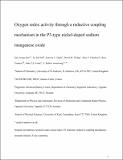Oxygen redox activity through a reductive coupling mechanism in the P3-type nickel-doped sodium manganese oxide
Abstract
Increasing dependence on rechargeable batteries for energy storage calls for the improvement of energy density of batteries. Toward this goal, introduction of positive electrode materials with high voltage and/or high capacity is in high demand. The use of oxygen chemistry in lithium and sodium layered oxides has been of interest to achieve high capacity. Nevertheless, a complete understanding of oxygen-based redox processes remains elusive especially in sodium ion batteries. Herein, a novel P3-type Na0.67Ni0.2Mn0.8O2, synthesized at low temperature, exhibits oxygen redox activity in high potentials. Characterization using a range of spectroscopic techniques reveals the anionic redox activity is stabilized by the reduction of Ni, because of the strong Ni 3d–O 2p hybridization states created during charge. This observation suggests that different route of oxygen redox processes occur in P3 structure materials, which can lead to the exploration of oxygen redox chemistry for further development in rechargeable batteries.
Citation
Kim , E J , Ma , L A , Duda , L C , Pickup , D M , Chadwick , A V , Younesi , R , Irvine , J T S & Armstrong , R 2020 , ' Oxygen redox activity through a reductive coupling mechanism in the P3-type nickel-doped sodium manganese oxide ' , ACS Applied Energy Materials , vol. Early View . https://doi.org/10.1021/acsaem.9b02171
Publication
ACS Applied Energy Materials
Status
Peer reviewed
ISSN
2574-0962Type
Journal article
Description
EJK would like to thank the Alistore ERI for the award of a studentship and Ok Sung Jeon at Yonsei University for ICP-OES measurement. The authors are grateful for the provision of beam time and assistance from instrument scientists at beamlines B18 at the Diamond Light source (as part of the Energy Materials Block Allocation Group SP14239), BL27SU at Spring 8 and GEM diffractometer at ISIS at the Rutherford Appleton Laboratory.Collections
Items in the St Andrews Research Repository are protected by copyright, with all rights reserved, unless otherwise indicated.

